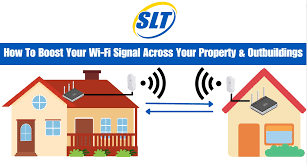Best Ways to Boost Your WiFi Signal at Home in 2025
Struggling with a weak WiFi signal at home? You’re not alone. With more devices relying on wireless connectivity—smartphones, laptops, TVs, and smart home gadgets—slow or spotty WiFi can be frustrating. Fortunately, there are proven and affordable ways to boost your WiFi signal and improve internet performance across your home.
In this guide, we’ll share the best tips and tools to get a stronger, faster WiFi connection—without needing to call your ISP.
1. Place Your Router in a Central Location
The position of your router has a huge impact on signal strength. WiFi signals spread out in all directions, so placing your router in a central, elevated area ensures more even coverage throughout the house.
Avoid placing it:
- Near thick walls or metal appliances
- In cabinets or behind furniture
- In basements or corners of your home
✅ Tip: If you’re using a dual-band router, keep it elevated and away from electronics that might cause interference.
2. Upgrade to a Modern WiFi Router
Still using a router from 2015? It’s probably time for an upgrade.
WiFi 6 and WiFi 6E routers offer:
- Faster speeds
- Greater range
- Better performance with multiple devices
Top routers like the ASUS RT-AX88U or Netgear Nighthawk AX12 are highly rated for home use in 2025.
3. Restart Your Router Regularly
Routers can slow down over time due to memory leaks or traffic congestion. A quick reboot every few days helps refresh the connection and clear up minor glitches.
You can:
- Set up a smart plug with a timer to auto-reboot your router
- Use the router’s admin dashboard to schedule restarts
4. Use a WiFi Range Extender or Repeater
If you have dead zones in your home (like upstairs bedrooms or garages), a WiFi extender can help.
Popular options include:
These devices repeat your WiFi signal, extending it further than your router can reach on its own.
5. Consider a Mesh WiFi System
For larger homes or places with thick walls, mesh WiFi systems provide seamless coverage by using multiple access points.
Top-rated mesh systems:
Mesh networks are ideal for eliminating dead zones and supporting multiple connected devices without signal drop.
6. Change WiFi Channel or Frequency Band
WiFi routers operate on different channels and frequency bands (2.4GHz and 5GHz). If your neighbors are on the same channel, it can cause congestion.
Steps to optimize:
- Log into your router’s admin panel (usually at 192.168.1.1)
- Change to a less crowded channel manually
- Switch devices between 2.4GHz (better range) and 5GHz (faster speed)
Use apps like NetSpot or WiFi Analyzer (Android) to scan your network.
7. Update Your Router’s Firmware
Manufacturers often release firmware updates that fix bugs and improve performance.
To update:
- Log into your router’s settings page
- Look for the “Firmware Update” section
- Download the latest version (some routers update automatically)
Keeping firmware updated also helps patch security vulnerabilities.
8. Use Ethernet for Stationary Devices
While WiFi is convenient, wired connections are more reliable and faster for stationary devices like:
- Desktop PCs
- Gaming consoles
- Smart TVs
Using Ethernet reduces WiFi load and improves performance for wireless devices elsewhere.
9. Limit Bandwidth-Hogging Apps
Streaming, gaming, and video calls can eat up bandwidth fast.
Solutions:
- Set Quality of Service (QoS) rules in your router settings to prioritize devices
- Limit auto-updates and background data on smart devices
- Pause or schedule heavy downloads during off-hours
Final Thoughts: A Stronger WiFi, A Smarter Home
Boosting your WiFi signal at home doesn’t have to be expensive or complicated. With the right router placement, updated equipment, and smart settings, you can enjoy faster, more reliable internet across every room.
